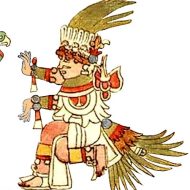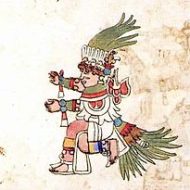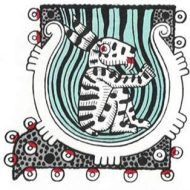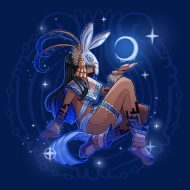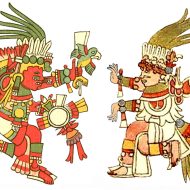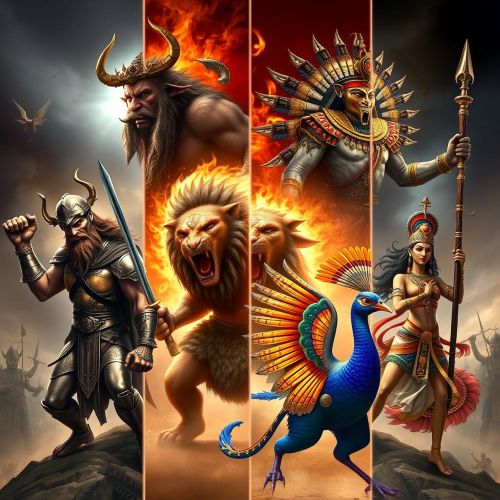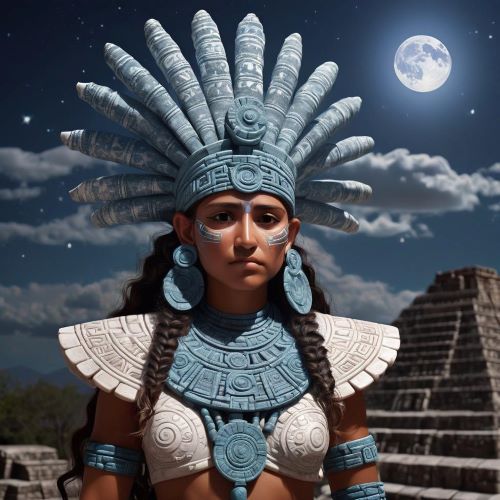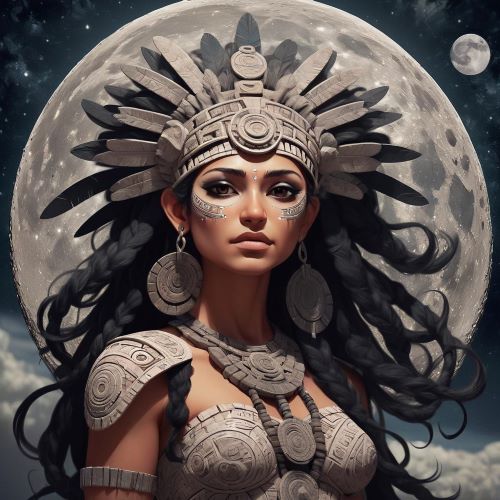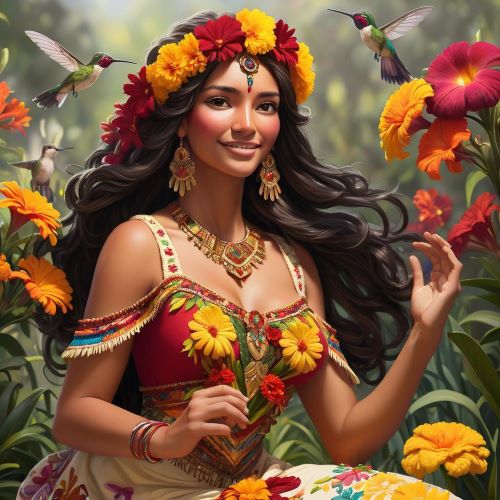Metztli : The Moon Goddess
Listen
At a glance
| Description | |
|---|---|
| Origin | Aztec Mythology |
| Classification | Gods |
| Family Members | Tonatiuh (Brother/Husband) |
| Region | Mexico |
| Associated With | Moon, Fertility, Harvest |
Metztli
Introduction
Metztli, alternatively referred to as Meztli or Metzi, holds a prominent role in Aztec mythology. Recognized as the goddess of the moon, she symbolizes the intricate duality of existence alongside her sibling, the sun god Tonatiuh. Together, they wield influence over the delicate equilibrium between day and night. Metztli’s ethereal glow casts a serene luminescence, gracefully painting shadows with its cool radiance, guiding nocturnal wanderers, and enveloping the world in a captivating silver dream. Beyond being a celestial orb, Metztli embodies the enigmatic essence of the night, the rhythmic forces of growth, and the profound interplay between light and darkness.
Physical Traits
Metztli is commonly portrayed carrying a moon seashell on her back, a visual representation of her profound connection to the moon and her revered role as the moon deity. When the moon is at its fullest, observers can discern the outline of a rabbit on its surface, further emphasizing Metztli’s lunar association.
Much like the moon’s ever-changing phases, Metztli’s appearance undergoes transformations in harmony with the lunar cycle. During the full moon, she emanates a gentle beauty, depicted as a youthful figure adorned with jade ornaments and robes woven from stardust. Though her countenance is serene, there lies a concealed depth, mirroring the wisdom accrued through ages past.
As the moon wanes, Metztli assumes a more mature aspect, at times represented as an aged crone draped in darkness, her eyes gleaming with otherworldly knowledge. Regardless of the specific form she takes, Metztli consistently bears the symbolic mark of the rabbit—a poignant emblem etched onto the moon’s surface, its origins embedded in an ancient celestial tale.
Family
Within the rich tapestry of Aztec mythology, Metztli holds the esteemed position as the sister of the sun god Tonatiuh. Their intertwined existence mirrors a symbiotic relationship, symbolizing the delicate equilibrium between day and night. Collaboratively, they preside over the celestial bodies, orchestrating the intricate dance of light and darkness that shapes the cosmos.
The roots of Metztli’s family tree delve deep into the heart of the Aztec pantheon. Often acknowledged as either the sister or wife of Tonatiuh, the radiant sun god, Metztli engages in a celestial ballet with its fiery counterpart. Together, they govern the expanse of the sky, their harmonious rhythms dictating the perpetual ebb and flow of time.
Various narratives weave Metztli into connections with other deities, expanding its familial ties within the divine realm. Some stories align Metztli with Yohaulticetl, the goddess revered for her associations with water and childbirth, underscoring the lunar deity’s nurturing and life-bestowing attributes. However, whispers in the mythological corridors also allude to Tecciztecatl, the male moon god, a darker entity embodying the potentially destructive power inherent in the moon’s enigmatic influence.
Other names
Metztli, alternatively rendered as Meztli and Metzi, carries a profound significance as its name directly translates to “Moon” in Nahuatl. The lunar deity, much like its diverse names, defies singular confinement, resembling the moon itself, which dons numerous masks, each unveiling a distinct facet of its essence. Among these aliases, Iztli, meaning “Knife of Obsidian,” embodies Metztli’s keen and vigilant gaze that pierces through the veil of darkness. Tecuhtli, translating to “Lord,” mirrors its authoritative presence over the night and its compelling influence on celestial bodies. Xocotlicue, or “Green Face,” intricately ties Metztli to the fertile earth and the rhythmic cycles of growth, revealing the deity’s multifaceted connections within the intricate web of Aztec symbolism.
Powers and Abilities
Metztli’s powers extend across the vast and enigmatic expanse of the night sky, mirroring the mysteries that shroud it. This celestial deity governs the tides, wielding influence over the rhythmic ebb and flow of the oceans, guarding the profound secrets they cradle. Its gentle luminescence serves as a guiding beacon for lost travelers, illuminating concealed paths in the darkness.
The moon’s magic, like a benevolent spell, infuses plants with the energy of growth, intricately shaping harvest cycles and nurturing the very soil beneath our feet. Metztli’s ethereal presence extends to the realm of dreams, where it weaves visions into the tapestry of the sleeping mind, offering glimpses into the unseen and the mystical.
In the delicate dance between light and darkness, Metztli’s power manifests as both a force of creation and destruction, a phenomenon simultaneously gentle and awe-inspiring. Within the cultural tapestry of the Aztecs, Metztli carries profound symbolism and significance. Revered for its association with fertility and harvest, this lunar deity was believed to bestow abundance and prosperity, ensuring bountiful harvests and the birth of healthy offspring.
However, beneath the benevolent facade, there exists a darker aspect to Metztli’s persona, entwining it with themes of witchcraft and mysticism. The moon’s influence on magic and its connection to sorcery attributed Metztli with the power to inflict illness, madness, and even orchestrate the transformation of humans into animals. This duality within Metztli’s nature adds a layer of complexity to its mythological presence, embodying both the nurturing giver of life and the enigmatic harbinger of supernatural forces.
Modern Day Influence
While the direct influence of Metztli in contemporary times lacks explicit documentation, the profound impact of Aztec mythology remains unmistakable. The enduring allure of Aztec culture and its intricate mythological narratives persists as a compelling subject of exploration and study, enriching our comprehension of ancient civilizations. The nuanced duality encapsulated by Metztli and Tonatiuh, symbolizing the delicate equilibrium between life and death, as well as the enduring dominion these deities hold over darkness and mystery, continues to captivate and serve as a wellspring of inspiration.
Metztli’s name graces celestial bodies, spacecraft, and even a popular Mexican beer, standing as a testament to its enduring cultural resonance. Artists and writers find creative fuel in its silvery light, infusing its essence into evocative paintings, poignant poems, and soul-stirring songs. Within spiritual communities, Wiccans and pagans venerate Metztli as a potent symbol of intuition, femininity, and the cyclical rhythm inherent in the tapestry of life.
Furthermore, in the realm of popular culture, where the moon and the night hold an enduring fascination, echoes of Metztli’s enigmatic power reverberate. This timeless influence is woven into contemporary narratives, manifesting in a collective fascination with the mysteries and allure of the lunar realm. In this way, the legacy of Metztli transcends the confines of ancient mythology, leaving an indelible mark on the cultural landscape and showcasing the enduring power of a deity whose essence continues to resonate across diverse facets of modern life.
Related Images
Frequently Asked Questions
What is lorem Ipsum?
I am text block. Click edit button to change this text. Lorem ipsum dolor sit amet, consectetur adipiscing elit. Ut elit tellus, luctus nec ullamcorper mattis, pulvinar dapibus leo.
What is lorem Ipsum?
I am text block. Click edit button to change this text. Lorem ipsum dolor sit amet, consectetur adipiscing elit. Ut elit tellus, luctus nec ullamcorper mattis, pulvinar dapibus leo.
What is lorem Ipsum?
I am text block. Click edit button to change this text. Lorem ipsum dolor sit amet, consectetur adipiscing elit. Ut elit tellus, luctus nec ullamcorper mattis, pulvinar dapibus leo.
What is lorem Ipsum?
I am text block. Click edit button to change this text. Lorem ipsum dolor sit amet, consectetur adipiscing elit. Ut elit tellus, luctus nec ullamcorper mattis, pulvinar dapibus leo.
What is lorem Ipsum?
I am text block. Click edit button to change this text. Lorem ipsum dolor sit amet, consectetur adipiscing elit. Ut elit tellus, luctus nec ullamcorper mattis, pulvinar dapibus leo.

